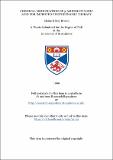Files in this item
Chemical modification of 5-aminolevulinic acid for improved photodynamic therapy
Item metadata
| dc.contributor.advisor | Butler, Anthony (Anthony R.) | |
| dc.contributor.author | Brown, Elaine Hilary | |
| dc.coverage.spatial | 229 p. | en_US |
| dc.date.accessioned | 2018-06-25T09:15:51Z | |
| dc.date.available | 2018-06-25T09:15:51Z | |
| dc.date.issued | 1999 | |
| dc.identifier.uri | https://hdl.handle.net/10023/14513 | |
| dc.description.abstract | 5-Aminolevulinic acid (ALA), one of the body's naturally occurring molecules in the biosynthetic pathway to haem, is being used in Photodynamic Therapy (PDT), a new approach to the treatment of cancer. It is a highly reactive molecule, which, upon standing in solution, dimerises to give 2,5-di-(beta-carboxyethyl) pyrazine. This reaction, and other similar ones, have been studied in some detail as it remains a major problem in the clinic, lowering the dose of active drug being administered and forming a molecule of which the toxicology is not known. The initial product of dimerisation is a dihydropyrazine, which is immediately oxidised in air to give a pyrazine. The chemistry of dihydropyrazines has also been investigated. The chemical synthesis of ALA itself has been optimised and derivatives of the molecule have been prepared to try to prevent this dimerisation from occurring and, potentially, increase the tissue selectivity of the drug. Twelve derivatives of ALA have been prepared and biologically tested for their activity in PDT. | en_US |
| dc.language.iso | en | en_US |
| dc.publisher | University of St Andrews | |
| dc.subject.lcc | QP552.B8 | |
| dc.subject.lcsh | Bone morphogenetic proteins | en |
| dc.title | Chemical modification of 5-aminolevulinic acid for improved photodynamic therapy | en_US |
| dc.type | Thesis | en_US |
| dc.contributor.sponsor | University of St Andrews | en_US |
| dc.type.qualificationlevel | Doctoral | en_US |
| dc.type.qualificationname | PhD Doctor of Philosophy | en_US |
| dc.publisher.institution | The University of St Andrews | en_US |
This item appears in the following Collection(s)
Items in the St Andrews Research Repository are protected by copyright, with all rights reserved, unless otherwise indicated.

